Vyrémorn Chess
Vyrémorn Chess is a large Chess Variant that has been developed since 1987 by Nathan McDonald.
To learn more about the development and background of the game, check out the Vyrémorn Chess Home Page.
The Rules:
|
Vyrémorn Chess is a fantasy chess variant designed with the relatively unique feature of being played diagonally on a board of two overlapping square areas, using both new and traditional pieces. There are 132 individual squares on the board, and each player starts with 33 pieces: |
| one King, |
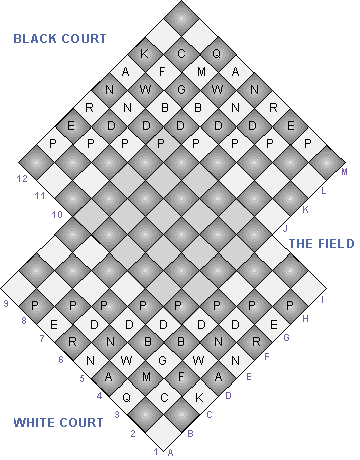 |
| one Queen, |
| one Magus, |
| one Citadel, |
| one Grand Bard, |
| one Flamen, |
| two Bards, |
| two Wings, |
| four KNights, |
| two Rooks, |
| two Arbalests, |
| two Elephants, |
| five Disks, |
| & eight Pawns. |
Playing:
Vyrémorn Chess is played much like traditional chess. The White player makes the first move by moving any piece, then the Black player moves a piece, and so on. Any piece with a legal move may open, including Mounting Disks, Castling, or moving into the Field. Castling, Extricating, and moving Mounted Disks are the only times when more than one piece is allowed to be moved in a turn.
The Board:
Vyrémorn Chess is played diagonally on a board comprised of two nine by nine checkered squares overlapping one another, offset five to the right and six to the left. The area of overlap is called the Field and has special properties that impacts the movement of pieces. The areas outside of the the Field are the Black & White Courts, depending on the color of the squares in the corners. The white pieces begin in the White Court, and the black pieces begin in the Black Court.
Click HERE To view an empty board, ready for printing.
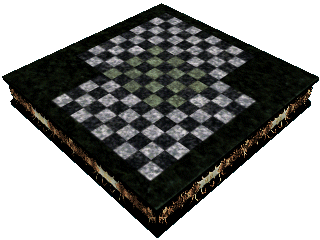
The Field:
The Field is the five by six square region in the center of the board, and is normally destinguished by having the 'white' squares tinted green. An optional method is to emphasise the Field with a dark border.
Whenever a Pawn or an Arbalest exits its native Court, it is promoted.
The specific affects of promotion can be found with the piece descriptions.
No piece can enter the Field from one Court and cross into the opposing Court in the same turn. The piece must instead remain in the Field until a subsequent turn, and then continue on. Some pieces may leap spaces, and can cross over the Field without restriction. These pieces are: the Magus, the Wing, and the Knight.
There are also two diagonal columns -one black, and one white- to either side of the Field directly connecting the Black and White Courts. These can be used to bypass the Field by any pieces capable of moving forward diagonally.
The Courts:
The Black and White Courts are the regions initially dominated by their respective Color's pieces, and can be determined by the color of squares in the corners.
The Magus, is restricted to the Courts, regardless of color. The only piece restricted to its native Court is the Citadel, which is designated as a defensive piece.
Other Common Terms:
- Flats: Squares that share sides.
- Points: Squares that meet only at the corners.
- Cardinals: Rows and columns of flats.
- Diagonals: Rows and columns of points.
Pieces:
| 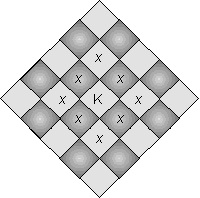 | The King:
The King can move or attack any adjacent point or flat, so long as it does not place itself in check by doing so. If the King is threatened, it must either be shielded by another piece, or moved out of Check. The King can enter the Field and mount Disks. The King can move beyond his ordinary range by Castling, or by being Extricated by the Magus. |
The Queen:
The Queen can move or attack on the diagonal or cardinal axis. The Queen can enter the Field and mount Disks. The Queen can bypass the Field on the diagonal axis to either side of the Field. | 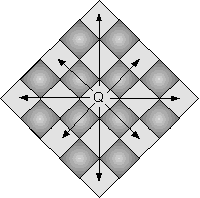 |
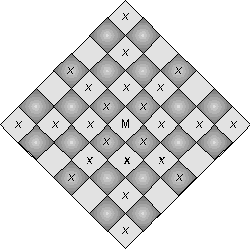 | The Magus:
The Magus can move or attack up to three squares away on the cardinal and diagonal axis, leaping intervening spaces. The Magus can mount Disks and leap, but not enter, the Field. The Magus can Extricate the King if he is able to make a legal move to the position of the King.
The Magus protects the King via supernatural forces, and is commonly represented as a hunched figure leaning upon a staff. |
The Citadel:
The Citadel can move to the adjacent flats, but has no attack options. The Citadel cannot mount Disks and cannot leave its native Court. The Citadel is a purely defensive piece, designed only to foil attack. No opposing pieces can capture or leap the Citadel except the Wing, which has multiple leaping paths that allow it to move 'around' The Citadel. The Citadel can be removed from the board only by Castling with the King.
The Citadel is normally represented by a Great-Tower or Keep. It is the only piece to match the King and Queen in stature. | 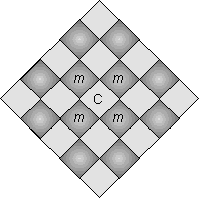 |
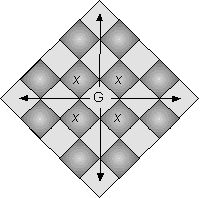 | The Grand Bard:The Grand Bard can move or attack on the diagonal axis or to the adjacent flats. The Grand Bard can enter the Field and mount Disks. The Grand Bard can also bypass the Field on the diagonal axis to either side of the Field.
The Grand Bard is a champion Warrior-Poet, skilled in both war and wit. It is normally represented by a large Harp. |
The Flamen:
The Flamen can move or attack on the cardinal axis or the adjacent points. The Flamen can enter the Field and mount Disks. Flamen was a title bestowed upon the high priests of certain Ancient Roman Gods. The Flamen is depicted as a figure hunched over an orb or flame. | 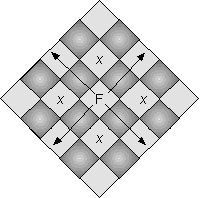 |
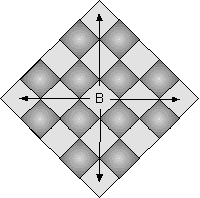 |
The Bard:
The Bard can move or attack on the diagonal axis. The Bard can enter the Field and mount Disks. The Bard can bypass the Field on the diagonal axis to either side of the Field. The Bard is normally restricted to a specific square color, but if a Bard is mounted on an attacking Disk, and then dismounts, the color occupied will be changed.
The Bard is a fearsome worrior-poet, and is represented by a Harp or Lyre. |
The Wing:
The Wing can either move to the adjacent flats, or move or attack in an L pattern, three flats out and one flat over (in that order),or two flats out and two flats over*, leaping the intervening spaces. The Wing can also enter or leap the Field and mount Disks. The Wing's leap cannot carry it over spaces not on the board.
The Wing is commonly represented as a Winged Cat or Griffon. * This is the only move that has multiple paths that can bypass the Citadel's defense.
| 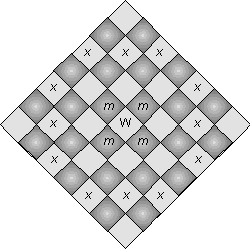 |
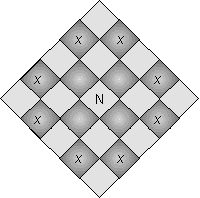 |
The Knight:
The Knight moves or attacks in an L pattern, two flats out and one flat over (in that order), leaping the intervening spaces. The Wing's leap cannot carry it over spaces not on the board.The Knight can also enter or leap the Field and mount Disks. |
The Rook:
The Rook can move or attack on the cardinal axis. The Rook can enter the Field and mount Disks. The Rook is a large, mobil, siege-tower and weapon platform. They are named for the habit of crows to nest in them when not in use (i.e. a rookery) | 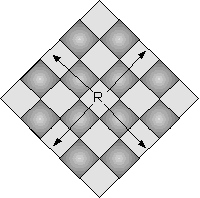 |
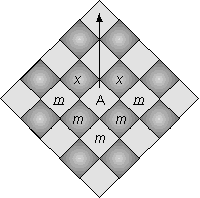 | The Arbalest:
The Arbalest moves or attacks on the forward diagonal axis and the forward flats, or moves without attacking to the adjacent backward flats and the backward point. When the Arbalest exits its native Court, it is promoted, and can move to left and right points. If any move returns the Arbalest to its native court, it is demoted until it once again exits the court. The Arbalest can enter the Field and mount Disks. The Arbalest can bypass the Field on the diagonal axis to either side of the Field.
The Arbalest is a type of cross-bow, and in is represented by one. |
The Elephant:The elephant moves or attacks the adjacent points and the second flats,
leaping the intervening space. The Elephant can also enter the Field and mount Disks. The Elephant is normally restricted to a specific square
color, but if an Elephant is mounted on an attacking Disk, and then dismounts, the color it occupies will be changed. | 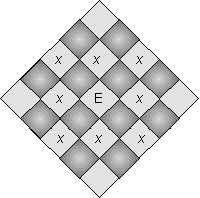 |
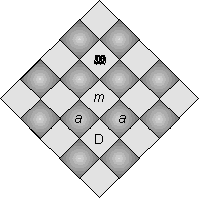 | The Disk:
The Disk can move only to the forward point, and attacks only to the forward flats. The Disk is allowed a two space opening move (not attack). The Disk can enter the Field. A Disk manuevered into the opposite corner of the board has no valid move, and is left on the board until captured, or the game ends. The Disk can be Mounted by any valid friendly piece. If a Mounted Disk is attacked, the piece mounted on the Disk is captured and the Disk is Turned. An unoccupied Disk is captured, not turned, when attacked.
The Disk is named for its icon, a disk, black on one side, white on the other. The disk is a representation of the giant shields wheeled forward to protect units as they advanced into battle. |
The Pawn:
The Pawn moves only to the forward flats, and attacks to the forward point.
The Pawn is allowed a two space opening move (not attack), during which it may leap an intervening and unoccupied Disk of the same color. If the first space in the two space opening move is threatened by an opposing piece, the two space open may not be taken. When the Pawn leaves its native court, it is promoted and can attack to the left and right points. If any move returns the Pawn to its own Court, it is demoted until it exits again. A Pawn manuevered into the opposite corner of the board has no valid move, and is left on the board until captured, or the game ends. | 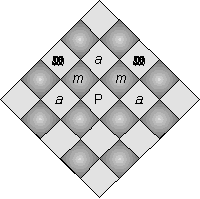 |
Special Moves:
Mounting:
A Disk can be Mounted by any friendly piece except the Citadel, a Pawn, or another Disk, so long as that piece's normal movement would place it on the space occupied by the Disk. No piece can cross (mount and dismount) a Disk in the same turn. The piece must instead occupy the Disk until a subsequent turn. Pieces occupying a Disk can either move off of the Disk in their normal manner, or remain on- and/or be moved with- the Disk.
Some pieces leap occupied spaces, and can leap over the Disk without restriction. These pieces are: the Magus, the Wing, the Knight, the Elephant, and the Pawn when making its optional two space opening move.
If an occupied Disk is attacked, the piece mounted on the Disk is captured and the Disk is Turned.
Turning:If an occupied Disk, is attacked, the piece mounted on the Disk is captured and the Disk is Turned to the color of the captor, unless the capturing piece is a Pawn or Disk, in which case the Disk is also captured. An unoccupied Disk is captured, not Turned, when attacked.
Castling:
Castling is a move that can be done only once by a player in a game. It allows the King to be moved beyond its
normal range, at the cost of the Citadel. It consists of the Citadel
being removed from the board, and the King being placed on the space vacated by the Citadel. Castling is subject to the following rules:
- The King must be in his native Court.
- The King must not be in Check.
- The King must not move into Check as a result
of Castling.
- If the King was occupying a Disk, the King is
removed from the disk.
Extricating:
Extricating is a move that also allows the King to
move beyond his normal range, trading places with the Magus.
Extricating can be performed as often as necessary, so long as the Magus is
in play. Extricating is subject to all of the following rules:
- The King cannot be in the Field.
- The King must be in check.
- The Magus must be able to physically move to
the square occupied by the King.
- The King must not move into Check as a result
of Extricating.
- If either the King or Magus were occupying a Disk, the Disk does not change positions.
Object of the Game:
Checkmate:
The game is won by checking the opposing King so
that no valid move will remove the King from threat.
Check:
The King is in Check when threatened with capture
by one or more opposing pieces. When the King is placed in check,
the player doing so must announce it by saying "Check".
One of three things must be done to defend the King:
- The King must move out of Check.
- The threatening piece Checking the King must be
captured.
- A piece must be placed between the King and the
attacking pieces, thus obstructing the threat.
Stalemate:
The game may also end in a draw or stalemate, according
to any one of the following conditions:
- The moving player can make no legal move and yet
the King is not in check.
- There are not enough pieces left on the board
to force a checkmate.
- When a player proves he can check the opposing
King endlessly.
- When fifty moves have passed for both players
without any pieces being captured.
- The players agree to a draw.
|















